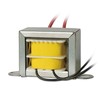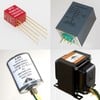Help with Cast Coil Transformers specifications:
General Specifications
Back to Top
|
|
| ||
| Winding Turns | |||
| Your choices are... | |||
| Step-Up Transformer | In step-up transformers, the secondary voltage is larger than the primary voltage. | ||
| Step-Down Transformer | In step-down transformers, the secondary voltage is smaller than the primary voltage. | ||
| Variable | The transformer has a setting to change the turn ratio as needed. | ||
| One to One | The transformer ratio is 1:1, or near 1:1. | ||
| Search Logic: | All products with ANY of the selected attributes will be returned as matches. Leaving all boxes unchecked will not limit the search criteria for this question; products with all attribute options will be returned as matches. | ||
| Other Transformer Types / Applications | |||
| Your choices are... | |||
| Three Phase / Polyphase Transformer | In polyphase (3-phase) transformers, the three primary windings are connected together and the three secondary windings are connected as well. | ||
| Single Phase Transformer | These are transformers that operate with single phase voltage. | ||
| Power Transformer | Power transformers convert one voltage to another at high power levels. Power transformers are used in electronic circuits and come in many different types and applications. Power transformers are sometimes considered to be those with ratings of 300 volt-amperes and below. These transformers normally provide power to the power supply of an electronic device, such as in power amplifiers in audio receivers. | ||
| Distribution Transformer | Distribution transformers are pole-type transformers that supply relatively small amounts of power to residences. They are used at the end of an electrical utility’s delivery system. Distribution transformers are used in electrical power distribution and transmission systems. These types of transformers have high power, or volt-ampere, ratings. The power rating is normally determined by the type of cooling methods the transformer may use. Some commonly-used methods of cooling include using oil or some other heat-conducting material. Ampere rating is increased in a distribution transformer by increasing the size of the primary and secondary windings; voltage ratings are increased by increasing the voltage rating of the insulation used in making the transformer. | ||
| Search Logic: | All products with ANY of the selected attributes will be returned as matches. Leaving all boxes unchecked will not limit the search criteria for this question; products with all attribute options will be returned as matches. | ||
| Core Type | |||
| Your choices are... | |||
| Laminated Core | Laminated transformers, or E-I transformers, contain laminated steel cores insulated with a nonconducting material such as varnish. They are formed into a core to reduce electrical losses. | ||
| Other | Other unlisted or proprietary core types. | ||
| Toroidal Core | Toroidal transformers typically consist of copper wire wrapped around a cylindrical core. This design prevents the magnetic flux that occurs within the coil from leaking. | ||
| Search Logic: | All products with ANY of the selected attributes will be returned as matches. Leaving all boxes unchecked will not limit the search criteria for this question; products with all attribute options will be returned as matches. | ||
| Mounting / Form Factor | |||
| Your choices are... | |||
| Chassis Mount | A chassis-mounted transformer has tabs to facilitate screwing it down. | ||
| Chip Transformer | Chip transformers have a form factor of an integrated circuit (IC) chip. They are typically manufactured using thin-film technology. | ||
| Dish / Disk Mount | A simple rubber washer and metal disk or dish secures the transformer to the chassis or board. There is usually a through-hole in the middle of the disk that allows for a screw to hold the transformer down. | ||
| H-Frame | H-frame mounting is used in applications where high vibration or shock is present. It is an "H" shaped frame that the transformer sits on. The frame is secured to the chassis or board. | ||
| Modular Jack | Magnetics incorporated into the RJ-45 form factor ensure high common mode noise immunity, while maintaining signal integrity. | ||
| Pad-Mounted | Pad-mounted transformers are mounted on the ground, sitting on a concrete (or other material) pad. They are normally step-down transformers used in power distribution systems to step down the voltage from the high voltage terminals of an underground distribution system to the low voltage of the end user’s needs. | ||
| PC / PCB Mount | Any of a variety of signal transformers mounted on PCBs. They can either be surface-mounted or through-hole configurations, using the soldering method to hold the transformers. PC-mount transformers offer a small footprint for the design engineer looking to measure sensor current or voltage on a computer board. Some applications for PC or PCB transformers include sensing current overload, ground fault detection, metering, isolated current feed-back signal in switch mode power supplies, motor current load / overload, lighting, switch controls, ultra-sound current, high resolution sonar current, and isolated bi-directional current sensor with full wave bridge. | ||
| Pole-Mounted | Pole-mounted transformers are installed on top of poles and are normally used as distribution step-down transformers servicing houses located close by. | ||
| Other | Other unlisted, specialized, or proprietary transformer mounting techniques. | ||
| Search Logic: | All products with ANY of the selected attributes will be returned as matches. Leaving all boxes unchecked will not limit the search criteria for this question; products with all attribute options will be returned as matches. | ||
Performance Specifications
Back to Top
|
|
| ||
| Operating Frequency Range | The frequency range for which the transformer will meet all guaranteed specifications. | ||
| Search Logic: | User may specify either, both, or neither of the "At Least" and "No More Than" values. Products returned as matches will meet all specified criteria. | ||
| Maximum Primary Voltage Rating | The maximum primary voltage rating is the input voltage range of the transformer. Transformers for use with several nominal voltages need more than one primary winding. Enter the maximum voltage required for the application. Matching products will list all primary voltages available in addition to the maximum specified. | ||
| Search Logic: | User may specify either, both, or neither of the "At Least" and "No More Than" values. Products returned as matches will meet all specified criteria. | ||
| Maximum Secondary Voltage Rating | The maximum secondary voltage rating is the output voltage range of the transformer. A transformer may provide more than one secondary voltage. Enter the maximum voltage required for the application. The matching products will list all secondary voltages available in addition to the maximum specified. | ||
| Search Logic: | User may specify either, both, or neither of the "At Least" and "No More Than" values. Products returned as matches will meet all specified criteria. | ||
| Power Rating (VA) | The rated power of the transformer is the sum of the VA (volts x amps) for all of the secondary windings. | ||
| Search Logic: | User may specify either, both, or neither of the "At Least" and "No More Than" values. Products returned as matches will meet all specified criteria. | ||
| Operating Temperature: | Full required range of ambient operating temperature. | ||
| Search Logic: | User may specify either, both, or neither of the limits in a "From - To" range; when both are specified, matching products will cover entire range. Products returned as matches will meet all specified criteria. | ||
Standards / Features
Back to Top
|
|
| ||
| Standards / Compliance | |||
| Your choices are... | |||
| RoHS Compliant | Restriction of Hazardous Substances (RoHS) is a European Union (EU) directive that requires all manufacturers of electronic and electrical equipment sold in Europe to demonstrate that their products contain only minimal levels of the following hazardous substances: lead, mercury, cadmium, hexavalent chromium, polybrominated biphenyl and polybrominated diphenyl ether. RoHS became effective on July 1, 2006. | ||
| ANSI | American National Standards Institute (ANSI) does not itself develop American National Standards, but it facilitates standards development by establishing consensus among qualified groups. | ||
| CSA | Canadian Standards Association (CSA) establishes standards of safety for products and helps preserve the environment. CSA tests and certifies products for national in international companies. | ||
| IEC | International Electrotechnical Commission (IEC) is the leading global organization that prepares and publishes international standards for all electrical, electronic, and related technologies. | ||
| MIL-STD | The transformer satisfies U.S. military standards or specifications (MIL-SPEC). There are many testing standards associated with MIL standards. | ||
| UL | Underwriters Laboratories Inc. (UL) is an independent, not-for-profit product safety testing and certification organization. | ||
| TUV | TÜV Rhineland Berlin-Brandenburg appraises tests and certifies technical equipment and products according to international quality standards, and then registers those in compliance. | ||
| VDE | The Germany-based VDE Testing & Certification Institute is accredited on a national and international level in the area of testing electrotechnical products. Testing is conducted for safety, electromagnetic compatibility, and other characteristics. | ||
| WEEE Compliant | Waste Electrical and Electronics Equipment (WEE) is a European Union (EU) Directive that aims to encourage the reuse, recycling, and recovery of electrical and electronic equipment, and to improve the environmental impact and performance of this equipment. WEEE establishes the requirements and criteria for the collection, treatment, recycling, and recovery of this equipment. It makes producers responsible for financing these activities, and retailers and distributors must provide means for consumers to return used or obsolete equipment without charge. | ||
| Other | Any other agency that that tests or certifies electrical, electronic, or electrotechnical products. | ||
| Search Logic: | All products with ANY of the selected attributes will be returned as matches. Leaving all boxes unchecked will not limit the search criteria for this question; products with all attribute options will be returned as matches. | ||
| Features | |||
| Your choices are... | |||
| Current Limiting Protection | The transformer has protection (such as fuses) to limit the amount of current through it. | ||
| Medical Grade | The transformer can be used in medical applications. | ||
| NEMA Enclosure | The transformer's enclosure satisfies NEMA standards. | ||
| Outdoor Use | The transformer can be used outdoors. | ||
| Seismic Qualified | The transformer is seismically tested and qualified and fulfills the requirements of the Uniform Building Code (UBC). | ||
| NEMA ST-20 Sound Level | The transformer is designed to comply with the NEMA ST-20 maximum sound levels. | ||
| Waterproof | The transformer has a waterproof case. | ||
| Search Logic: | All products with ANY of the selected attributes will be returned as matches. Leaving all boxes unchecked will not limit the search criteria for this question; products with all attribute options will be returned as matches. | ||


